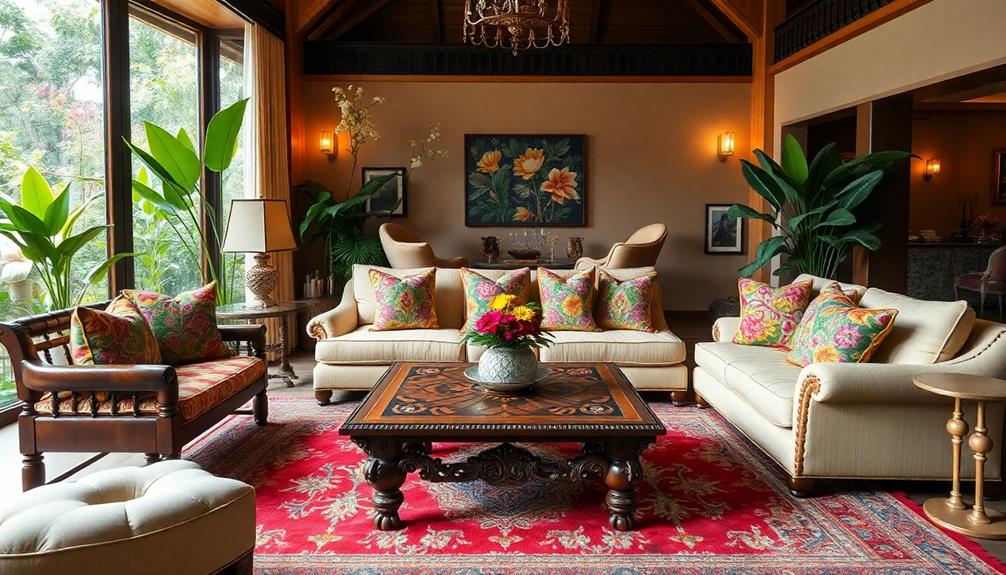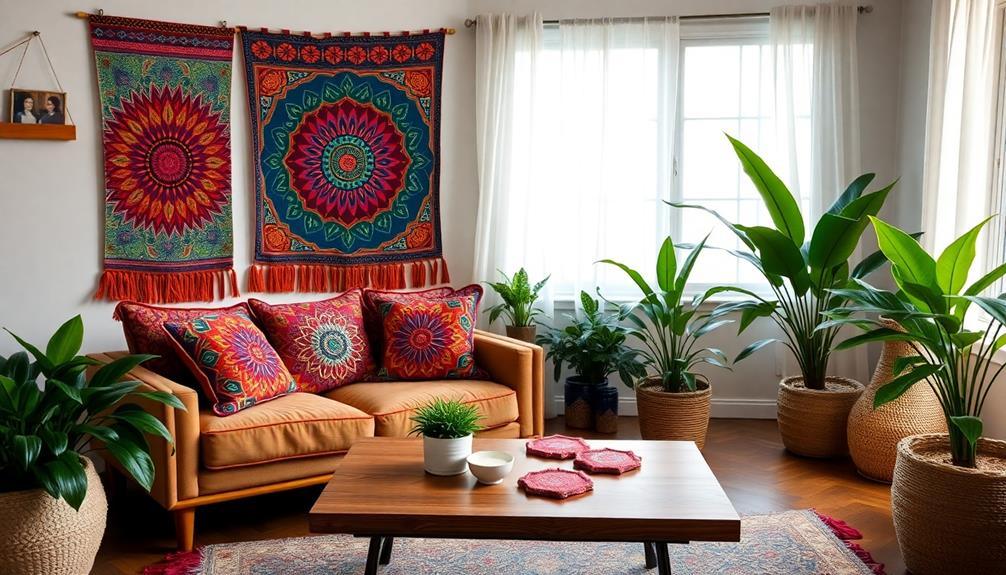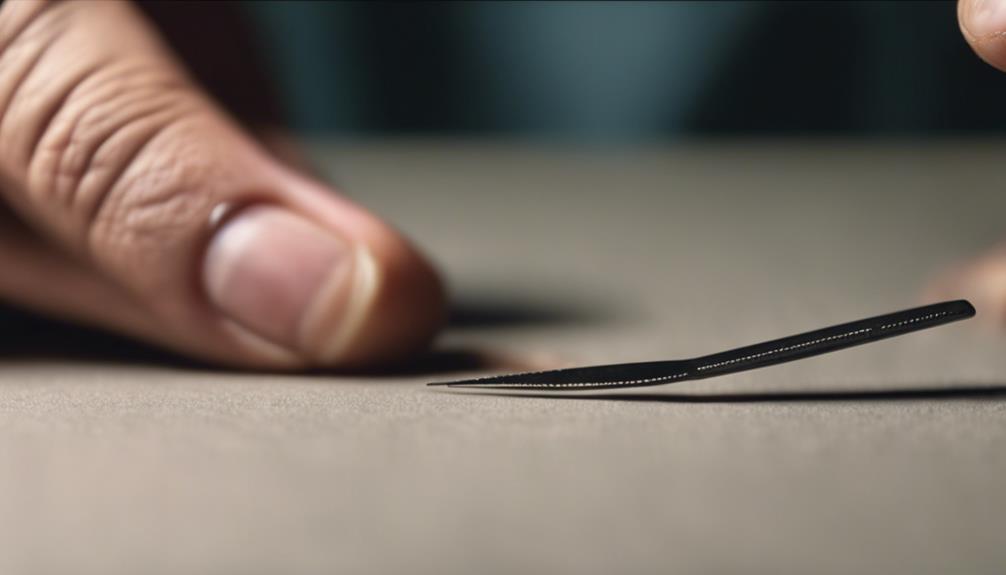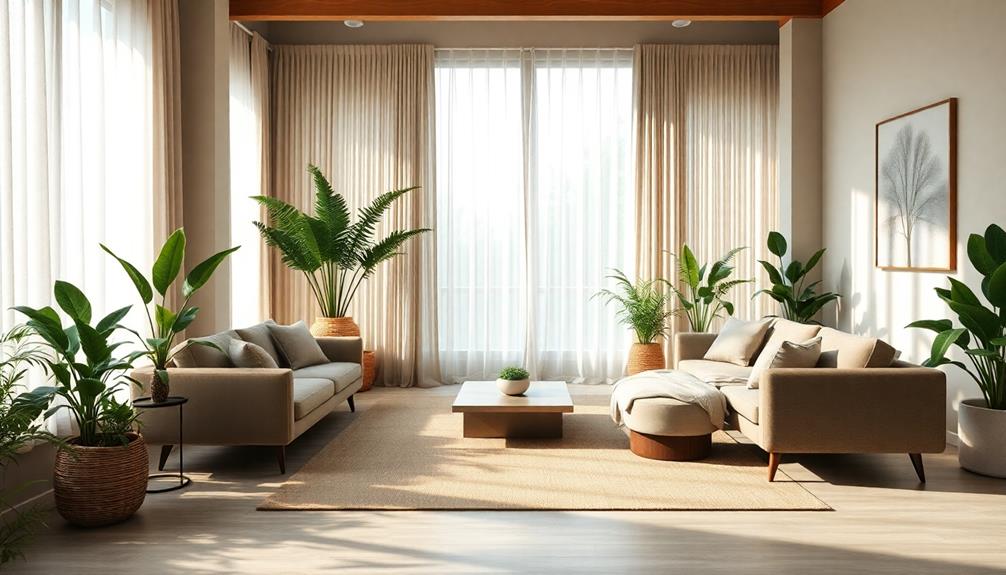You can effortlessly achieve a luxe look on a budget by incorporating stunning Indonesian textiles into your decor. Start by selecting vibrant fabrics like Batik or Ikat, known for their intricate designs. Use these textiles to create statement pieces, like wall hangings or throw pillows, that grab attention. Layer different textures for depth, combining smooth silks with handwoven options for contrast. Don't forget to explore local markets or online platforms for affordable finds. With a little creativity, you can elevate your space while celebrating cultural artistry. Keep going, and you'll uncover even more ways to enhance your home style.
Key Takeaways
- Utilize vibrant Indonesian textiles, like batik and ikat, to create statement pieces that enhance visual interest in your decor.
- Layer different textures and patterns, combining smooth silk with handwoven fabrics for a luxurious yet budget-friendly look.
- Incorporate textile accessories, such as cushions and wall hangings, to add color and cultural depth without overspending.
- Shop at local markets, artisan fairs, or thrift stores for authentic textiles at affordable prices to achieve a luxe aesthetic.
- DIY projects, like creating throw pillows or table runners from Indonesian fabrics, can elevate decor while staying within budget.
Understanding Indonesian Textiles
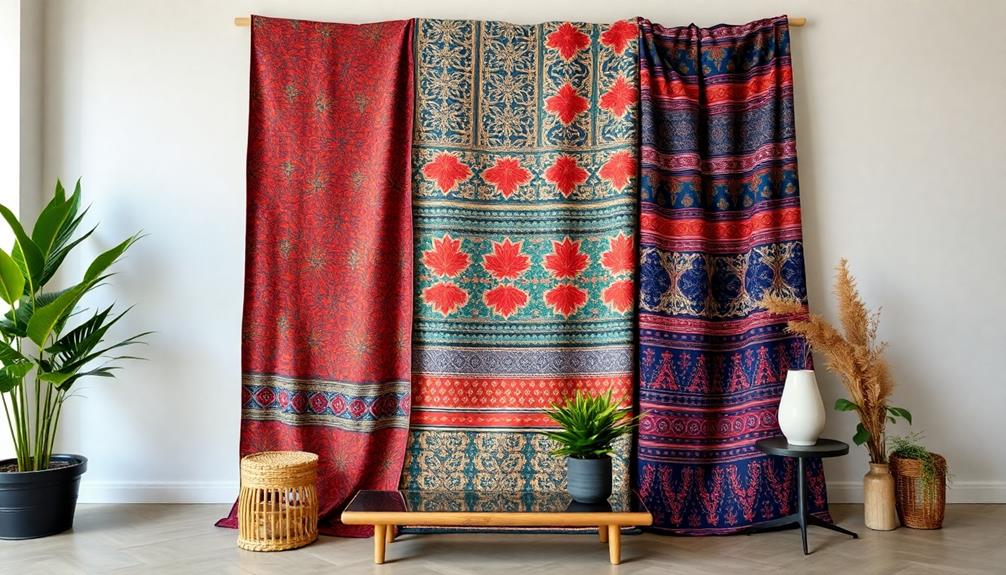
When diving into the world of Indonesian textiles, you'll quickly uncover a rich tapestry of culture and artistry. These textiles, like batik and ikat, are celebrated for their intricate patterns and vibrant colors, each telling a story rooted in cultural heritage.
Batik, for instance, employs a wax-resist dyeing technique that allows artisans to create detailed designs before dyeing the fabric, showcasing the skill involved in this time-honored craft.
On the other hand, ikat involves tying and dyeing threads before weaving, resulting in unique patterns that often appear blurred or softened, adding depth to the fabric.
You'll find that traditional Indonesian textiles feature significant motifs, such as the naga (dragon) and floral designs, which carry deep meanings, from prosperity to spirituality.
Moreover, many artisans prioritize sustainable practices by using natural materials like cotton and silk. This commitment not only enhances the quality of the textiles but also supports eco-friendly methods.
Choosing the Right Fabrics
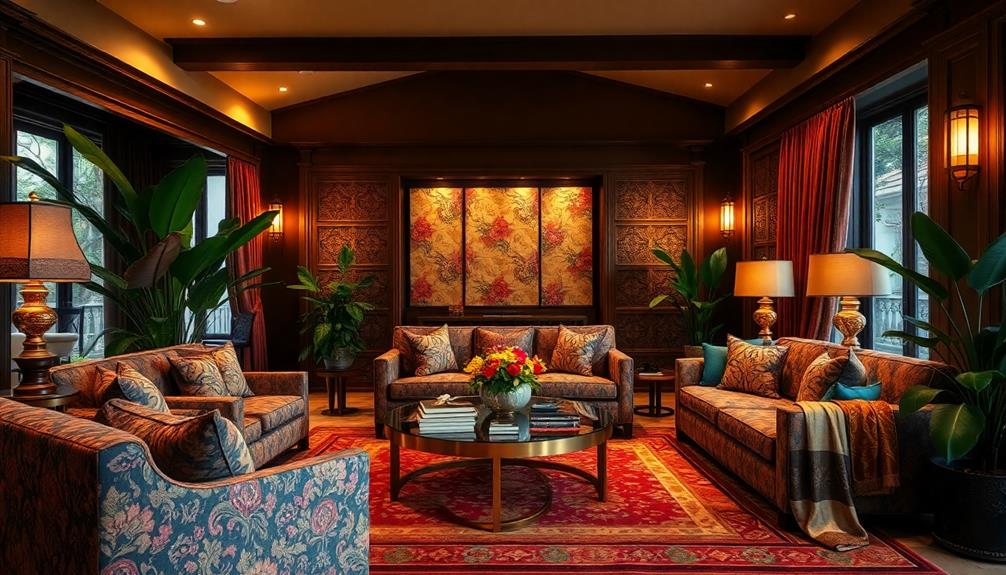
Choosing the right fabrics can transform your space and elevate your luxe look without breaking the bank. When you're selecting Indonesian textiles, focus on intricate craftsmanship like Batik and Ikat. These fabrics showcase unique patterns and colors that add to your aesthetic. Opting for natural fibers, such as cotton and silk, gives your decor a luxurious feel while enhancing durability and comfort.
To help you choose the best fabrics, consider the following:
| Fabric Type | Key Features |
|---|---|
| Batik | Unique patterns, cultural heritage |
| Ikat | Vibrant hues, rich textures |
| Sumba Textiles | Warmth and character |
| Lampung Textiles | Statement pieces, artistic techniques |
Incorporating handwoven textiles as statement pieces will reflect rich cultural heritage while providing a sophisticated appearance. Mixing these vibrant fabrics with modern decor elements creates a stylish contrast that makes your space stand out. By selecting the right Indonesian textiles, you can achieve a luxe look on a budget, allowing you to enjoy the beauty and comfort they bring to your home.
Statement Pieces for Impact
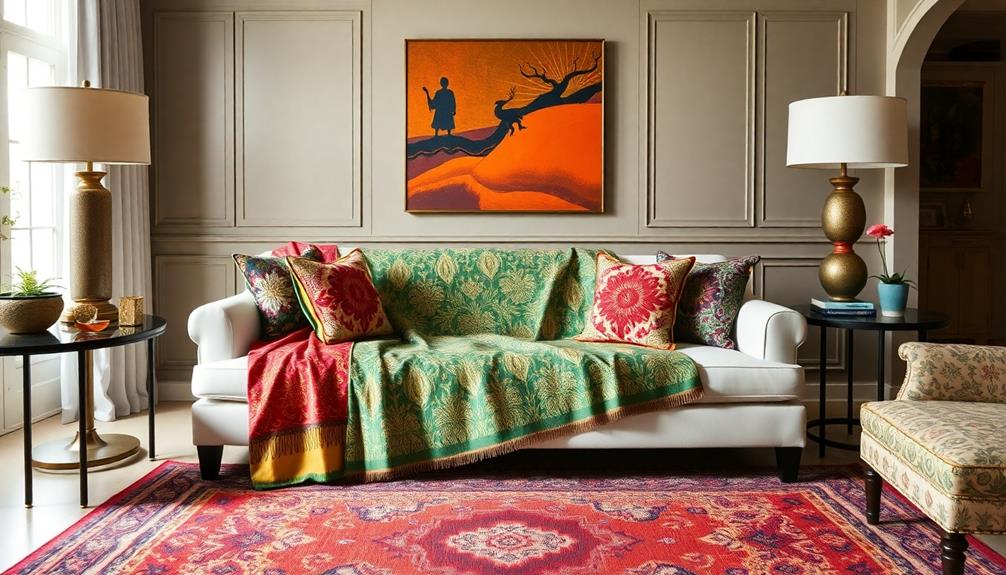
Incorporating statement pieces into your decor can dramatically enhance the luxe look you're aiming for. Consider using Indonesian textiles like batik or ikat to add rich cultural depth and visual interest to your space.
Additionally, exploring the vibrant artistry of Indonesian decor masks can complement these textiles beautifully, as they often reflect local traditions and craftsmanship. A bold batik wall hanging or a vibrant ikat throw can serve as a focal point, capturing attention with their intricate patterns and colors.
Mixing and matching these textiles allows you to create a dynamic visual effect, showcasing the diversity and artistry inherent in these fabrics while maintaining an elegant and sophisticated look. You don't need to spend a fortune; handmade Indonesian textiles, when used as table runners or cushion covers, introduce a luxurious touch without breaking the budget.
Affordable Indonesian decor masks can also enhance your space, providing an economical way to celebrate cultural heritage.
Investing in a few high-quality pieces can elevate your decor, providing a sophisticated touch that resonates with timeless elegance. These textiles often feature traditional techniques and designs, adding an authentic flair to your home.
Creative Ways to Use Textiles
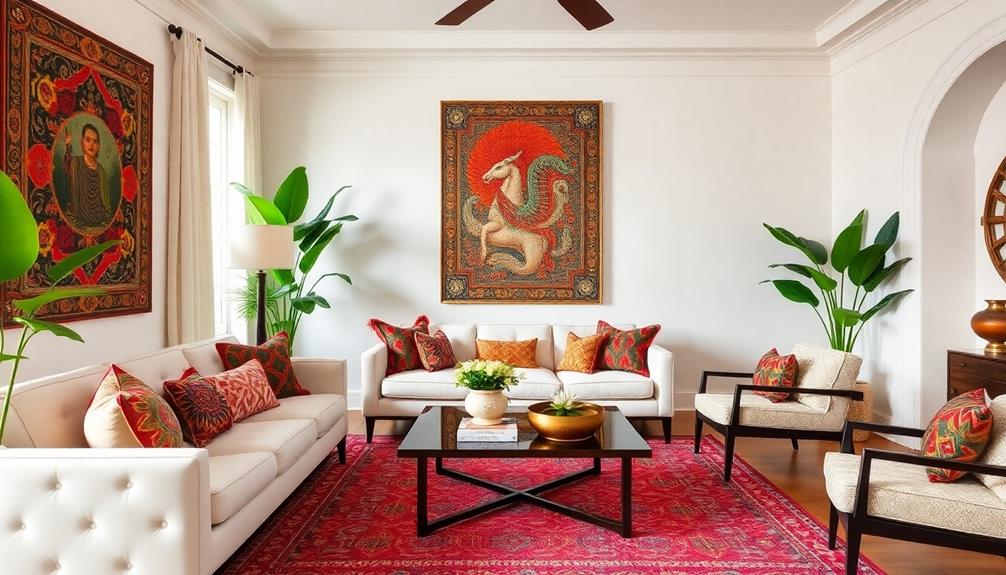
When you're looking to add a touch of luxury to your space, consider how textile layering can create depth and intrigue.
Upcycling vintage fabrics into unique accessories not only showcases your personal style but also brings a story to your decor.
Plus, incorporating statement textile pieces can tie your whole aesthetic together while staying budget-friendly.
Textile Layering Techniques
Layering textiles can instantly elevate your decor, adding both depth and character. By utilizing Indonesian textiles like batik, ikat, and tenun, you can create a rich and inviting atmosphere in your home. Incorporating elements like Indonesian decorative pillows enhances comfort while showcasing vibrant colors and intricate patterns.
Start by mixing and matching high-quality textile pieces, such as vibrant table runners and plush cushions, to introduce a luxurious vibe that's also comfortable. For instance, drape an ikat throw over a traditional wooden chair to add texture and warmth.
You can also use oversized textiles as statement wall art; hanging a beautifully woven tapis or batik as a focal point transforms an ordinary wall into a stunning display of artistry.
Don't forget to layer different patterns and textures—this not only enhances visual interest but also showcases the diverse fabric heritage of Indonesia. By incorporating various decor pieces, you can create a cohesive yet dynamic look that feels curated.
Investing in high-quality textile pieces allows for elegant layering that stands the test of time, ensuring your decor remains stylish without breaking the bank. Embrace textile layering to achieve a home that exudes both elegance and authenticity.
Upcycling Vintage Fabrics
Transforming vintage Indonesian textiles into new decor pieces is a creative way to breathe life into your space while honoring cultural heritage. Upcycling these fabrics, like batik or ikat, can add a unique cultural touch to your home, celebrating the artistry of traditional craftsmanship.
Consider crafting stylish cushion covers or throw pillows that showcase the intricate patterns, instantly elevating your decor. You can also create stunning wall hangings or tapestries, allowing these vintage textiles to serve as eye-catching art pieces.
If you're looking to enhance your dining experience, repurpose these fabrics into vibrant table runners or placemats, promoting sustainable design practices while infusing your space with color.
Don't overlook smaller projects, either. Use old fabric scraps to craft decorative items like fabric-covered storage boxes or unique gift wraps that blend functionality with the rich heritage of Indonesian textile art.
If you have worn-out garments, transform them into stylish bags or accessories, giving new life to the fabric and allowing for a personalized fashion statement. Upcycling vintage textiles not only enhances your decor but also contributes to a sustainable lifestyle, making your space truly one-of-a-kind.
Statement Textile Accessories
Textile accessories can be the game-changer your space needs, adding personality and flair without stretching your budget. By incorporating statement textile accessories, you can transform your home with affordable pieces that add a touch of elegance and vibrant pops of color.
Indonesian textiles, known for their rich cultural heritage and craftsmanship, can truly enhance your decor. Here are some creative ideas to get you started:
- Cushions and Throws: Use Indonesian batik or ikat fabrics for cushions and throws. They infuse your space with intricate patterns and rich colors, showcasing cultural heritage. These handcrafted pieces often reflect regional artistic styles, making them unique additions to your home.
- Wall Hangings: Hang a large piece of handwoven tapis as a stunning wall art focal point. This not only highlights artistry but also adds warmth. Consider pairing it with a Face Indonesian Decor Mask to further celebrate traditional craftsmanship in your space.
- Table Runners: Layer a colorful Indonesian textile as a table runner. Instantly, it brings texture and a cozy feel to your dining area or living space.
- Gallery Walls: Create a gallery wall featuring framed sections of Indonesian textiles. This allows you to display their beauty as art, maintaining a cohesive and chic aesthetic.
With these ideas, you can effortlessly elevate your decor while celebrating the unique charm of Indonesian textiles.
Layering Fabrics for Depth
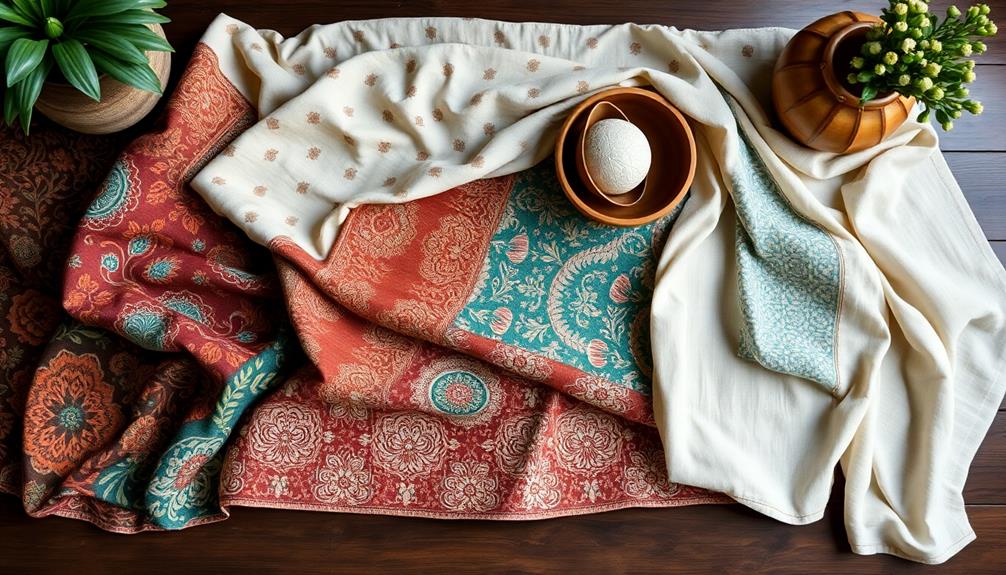
Layering fabrics is a game-changer for adding depth to your space.
By mixing textures and patterns, you can create a dynamic look that feels both rich and inviting.
Consider incorporating traditional textiles that reflect traditional Indonesian style home decor to enhance the cultural significance of your design.
Don't shy away from incorporating vibrant accents; they'll elevate your decor and keep things visually interesting.
Mixing Textures and Patterns
A well-curated mix of textures and patterns can instantly elevate your space, creating a sense of depth and sophistication.
By layering various Indonesian textiles, you can transform any room into a luxurious haven. Traditional Indonesian textiles not only showcase exquisite craftsmanship but also reflect cultural significance through their vibrant designs and patterns.
Here are some tips to help you achieve that:
- Combine Different Textures: Pair the smoothness of silk with the roughness of handwoven rattan. This contrast not only adds visual interest but also invites touch.
- Incorporate Patterned Textiles: Use traditional tapis alongside solid colors to create striking focal points. These patterned textiles can tie the room together while making a statement.
- Use Throw Pillows: Incorporate throw pillows made from diverse materials. They're affordable accessories to add and perfect for seasonal updates, giving your space a fresh look.
- Strategic Placement: Arrange mixed textiles on sofas, chairs, or beds. This strategic placement enhances the overall design, evoking the feel of high-end interiors without breaking the bank.
Incorporating Vibrant Accents
Vibrant accents can transform a room, bringing it to life with color and energy. By layering Indonesian textiles, such as batik and ikat, you introduce rich patterns and vibrant colors that enhance visual depth. This layering creates a luxe ambiance that feels inviting and sophisticated.
Incorporating unique Indonesian decor masks can further amplify this effect, as they represent a rich cultural heritage and add a striking focal point to your space an enriching cultural element. Combine various fabric textures, like silk with cotton or linen, to add tactile interest while showcasing the craftsmanship of these traditional textiles.
Incorporating colorful throws and cushions made from these fabrics can easily turn a simple sofa or bed into a stylish focal point. These pieces not only serve as functional decor but also act as statement pieces that draw the eye and elevate your overall aesthetic.
Don't hesitate to mix and match textiles from different regions of Indonesia. This approach allows you to create a unique and personalized decor style that celebrates the diverse cultural heritage of the country.
Layering for Visual Interest
Textures play an essential role in creating depth and visual interest in your space.
By layering different types of Indonesian textiles, you can enhance your decor aesthetic while celebrating cultural craftsmanship.
This approach aligns beautifully with the Balinese design philosophy, which emphasizes natural materials and a connection to nature traditional craftsmanship.
Here are some ways to effectively layer textiles:
- Sheer and Heavy Drapes: Combine sheer curtains with heavier drapes. This dynamic interplay of light and fabric adds sophistication without overwhelming the room.
- Contrasting Pillows: Use vibrant throw pillows against neutral upholstery. This striking contrast not only elevates your decor aesthetic but also creates visual interest in your seating area.
- Layered Rugs: Place a patterned area rug over a solid floor. This technique anchors the room and introduces warmth, making your space feel more inviting and luxurious.
- Textile Wall Hangings: Hang Indonesian textiles as art pieces. This unique display adds depth and character, showcasing the beauty of cultural craftsmanship.
Color Palette Considerations
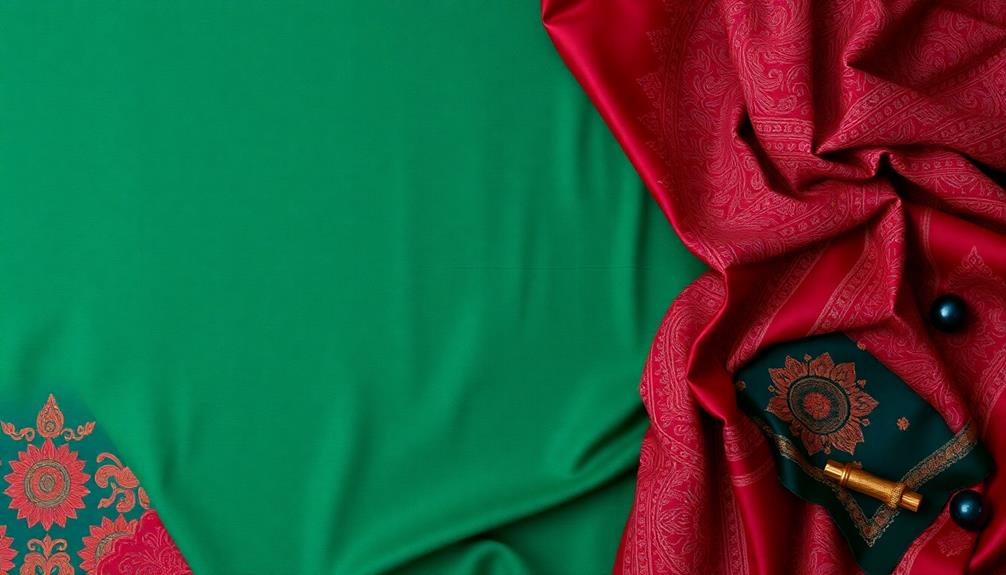
Creating a luxe look on a budget starts with carefully selecting your color palette. To achieve a harmonious and sophisticated atmosphere, consider a mix of neutral tones as your base. This allows the vibrant and intricate patterns of Indonesian textiles to shine as striking accents. Incorporating deep reds, rich blues, and earthy tones can evoke the traditional beauty of batik and ikat designs.
To add depth and luxury, don't forget to integrate metallic accents inspired by gold-wrapped threads in traditional textiles. These shimmering details can elevate your overall aesthetic. Layering textures is also essential—combine smooth fabrics with the intricate designs of Indonesian textiles to create visual interest.
Here's a quick reference to help you choose your colors:
| Base Color | Accent Color |
|---|---|
| Soft Beige | Deep Red |
| Cool Gray | Rich Blue |
| Warm Taupe | Earthy Green |
| Cream | Metallic Gold |
| Off-White | Vibrant Orange |
Incorporating Textiles With Furniture
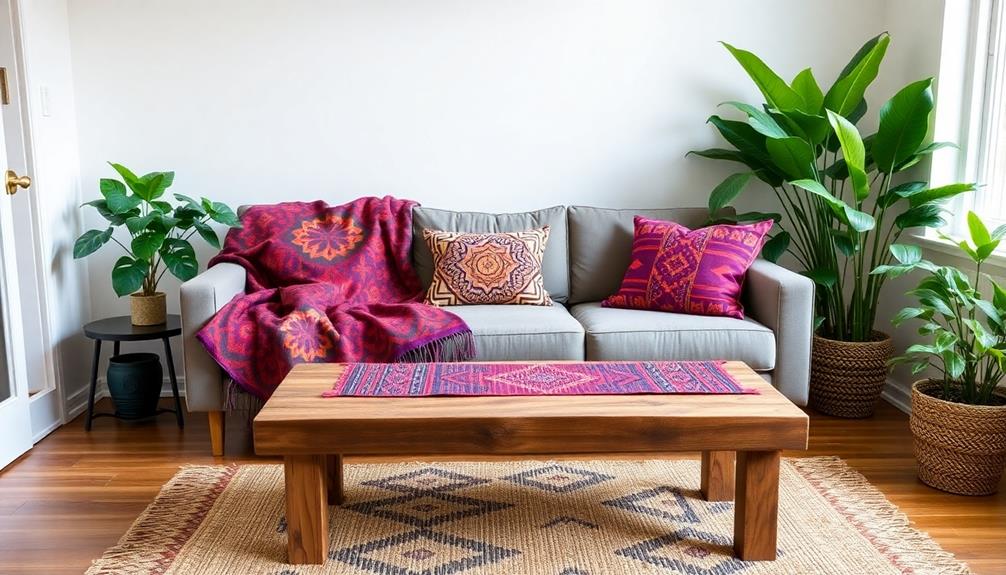
When you've established a sophisticated color palette, it's time to bring that vision to life by incorporating Indonesian textiles with your furniture. These textiles can transform your space without a complete overhaul, adding richness and warmth.
The vibrant colors and intricate patterns characteristic of Southeast Asia Decor can enhance the overall aesthetic of your home, creating an inviting atmosphere.
Here are four ways to seamlessly blend Indonesian textiles with your furniture:
- Reupholstering Dining Chairs: Use vibrant Indonesian textiles to give your dining chairs a fresh, unique look. This creates focal points that elevate your dining experience.
- Incorporating Textile-Covered Poufs: Add textile-covered poufs or ottomans for versatile accent pieces. They not only provide extra seating but also introduce a pop of color to your room.
- Drapes and Throws: Utilize Indonesian textiles as drapes or throws, infusing luxury textures and cultural significance into your living space. They'll add style while ensuring comfort.
- Layering Accents: Layer table runners or placemats made from Indonesian textiles on your furniture surfaces. This showcases traditional craftsmanship and creates an inviting atmosphere.
Affordable Sources for Textiles

Finding affordable sources for Indonesian textiles can be an exciting adventure that enriches your decor without stretching your budget. Start by exploring local markets and artisan fairs in Indonesia, where you'll discover traditional textiles like batik and ikat at reasonable prices, often purchased directly from the makers.
You might also come across beautiful traditional motifs and patterns that enhance the cultural significance of your decor. If you're shopping from home, don't overlook online platforms like Etsy and sustainable fashion websites. They offer a range of unique pieces while supporting local artisans.
Thrift stores and second-hand shops can also be treasure troves for vintage Indonesian textiles. You'll find unique pieces that add character to your space without breaking the bank.
Another great option is to purchase remnant fabrics from textile manufacturers. They often sell excess material at discounted rates, perfect for creating beautiful accent pieces or engaging in DIY projects.
Lastly, utilize social media groups and marketplaces focused on Indonesian handicrafts. There, you can find deals and connect with sellers offering authentic textiles at competitive prices.
DIY Projects With Textiles

Transforming your space with DIY projects using Indonesian textiles can be both rewarding and budget-friendly. By incorporating these vibrant fabrics, you can achieve a luxurious feel without breaking the bank.
Consider exploring local shops that offer unique pieces, like sustainable craftsmanship, to find the perfect textiles for your projects. Here are four creative DIY projects to get you started:
- Throw Pillows: Use traditional Indonesian textiles like batik or ikat to create throw pillows or cushion covers. They'll instantly elevate your living area while adding a unique decorative element.
- Wall Hangings: Upcycle vintage textiles into stunning wall hangings or framed art pieces. This showcases Indonesian craftsmanship and adds a personal touch to your decor.
- Table Runners: Craft table runners or placemats from colorful Indonesian fabrics. This simple project can transform your dining experience, giving an elegant touch to everyday meals.
- Storage Solutions: Repurpose textile remnants into decorative storage baskets or organizers. This not only promotes a chic and organized aesthetic but also helps reduce waste.
Maintaining Textile Quality

Maintaining the quality of your Indonesian textiles is essential for preserving their beauty and longevity. Start by hand washing or dry cleaning your fabrics with mild detergents to protect their vibrant colors and intricate patterns. Avoid direct sunlight when displaying these textiles, as prolonged exposure can lead to fading and deterioration.
When it comes to storing your textiles, choose a cool, dry place. Rolling them instead of folding helps prevent creases and maintains their structure over time. Regularly inspect textiles for signs of wear or damage. If you notice loose threads or small tears, address these issues promptly to prolong their lifespan.
For long-term storage, use breathable storage bags or acid-free tissue paper. These options protect your textiles from dust, moisture, and pests, ensuring they remain in excellent condition.
Frequently Asked Questions
How to Make Your Home Look Elegant on a Budget?
To make your home look elegant on a budget, focus on layering textures, choosing a cohesive color palette, and incorporating statement pieces. Small, intentional updates can transform your space without overwhelming your finances.
How Can I Make My Home Look Better?
Imagine your home as a canvas; you're the artist. Start by decluttering, adding vibrant accents, and mixing textures. Incorporate personal touches that reflect your style and memories, transforming your space into a haven you adore.
Conclusion
Creating a luxe look on a budget with Indonesian textiles isn't just a possibility; it's practically an art form! By choosing vibrant fabrics and turning them into stunning statement pieces, you'll transform your space into a high-end haven without breaking the bank. With just a dash of creativity and a sprinkle of DIY magic, you can elevate your home to levels of elegance that'll have your friends convinced you've won the lottery! So, go ahead and get started!

